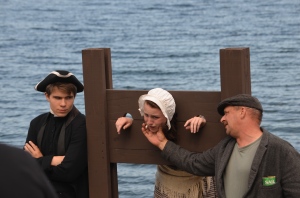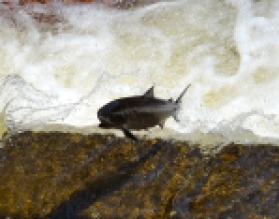We left St. John’s in the morning and started the drive towards the west coast. The drive
“It’s all right while you’re exploring.
You get used to rotten meat, frozen fingers, lice, and dirt.
The hard times come when you get back.”
– Bob Bartlett (Log 13)
During the more than 50 years of his seafaring life, Captain Robert (Bob) Abram Bartlett skippered some of the most famous, dangerous, and controversial exploratory expeditions to the Arctic. He travelled further north than almost any other living person, was shipwrecked at least 12 times, survived for months in the inhospitable Arctic after sea ice crushed his ship, and journeyed hundreds of miles by dogsled to reach civilization. Despite these hardships, Bartlett returned to the Arctic whenever circumstance allowed and almost always came back with photographs, film reels, and scientific data that greatly contributed to the world’s understanding of the north.
There were signs leading us to the “Tunnel”, Janice was afraid we would get there and the RT would not fit, it was not part of the road!

The tunnel is through solid rock on the waterfront
We then continued on to Trinity which has been a viable North Atlantic community for hundreds of years. Its defensible harbor, with abundant room for the ships of the day and shores well suited for outbuildings, wharves and fish-flakes, made it ideal for the early migratory fishery. Later, merchants from Poole, England, made Trinity the base for a new-world fishery. During the 1720’s Trinity was home to about 30 permanent families and host to 200-300 seasonal fishermen per year. By 1869, the population peaked at more than 800 people. Until recently, the inshore, Grand Bank and Labrador fisheries sustained the community. The buildings in the town are well-preserved and it is as much an active residential working town as it is a most notable “heritage community”. Sustainable growth in existing and new businesses, including theater, is clearly evident as Trinitarians, along with residents of the surrounding communities, play host to thousands of visitors per year.
We arrived just in time for The Rising Tide Theater’s The New Founde Lande Trinity Pageant.The play takes you on a journey through the lanes, roads and historic sites of

Trinity. The characters are wonderful as the story unfolds giving a sense of history to Newfoundland with humor and sadness from the early settlers through the 1830’s and 40’s in story and song.
It presented the resourcefulness of the people, the hardships of death and “owned by the company store” and not being able to bring enough catch to payback

the advances and interest for the winter. The play is very well done and one of the highlights of our trip. If you come to Newfoundland, make plans to see it performed. It is presented every Wed & Sat at 2pm.
We spent the night at Terra Nova National Park which was just beautiful. We were sorry that we hadn’t planned on a few days in the park. In the morning, we were surprised at the amount of oncoming traffic going east to St John’s. We then remembered there was a major concert in Windsor/Grand Falls the night before. We stopped in a Micky D’s to use the internet and were amused by all the kids from the concert wearing Aerosmith t-shirts. They loved Stephen Tyler. It is amazing what American Idol and Donald Trump’s show can do for washed up careers in the entertainment business.
When we got to Windsor/Grand Falls we went to the Salmonid Interpretation Center where the Atlantic Salmon travel up the fish ladders, many were making their way up-stream.

on their way to their spawning grounds. We visited one in the Yukon last year and there were a few differences between the Atlantic Salmon and the Pacific. The Pacific Salmon spawn only once and die, the Atlantic Salmon can spawn several times. The Atlantic Salmon is so “fished out” that there isn’t any commercial fishing and individuals can only catch 6 per year. We kept looking for fresh wild Atlantic Salmon in fish stores and now know why there are only farm raised that are available.

Janice, who has the “patience of Job” when it comes to picture-taking, stood for 30 minutes to get these few great pictures of the fish flying over the ladders.
On to Gros Morne National Park. This is considered Newfoundland’s greatest treasure. Geologists have been able to show that 420 to 570 million years ago, the rocks in Gros Morne were part of an ancient ocean that was later thrust up to become part of the Appalachian Mountains as two continents collided. These rocks give support to the theory of plate tectonics have provided important insights into how this process works. More recently in geological terms, glaciers carved this place into the spectacular landscape that we visited.
The first evening we were told about a great evening cruise out of Norris Point. We arrived about 6:00 for the 7:00 cruise to be told that they did not have a Sunday cruise. Two couples were in front of us and had confirmations for the evening. The cruise provider apologized for the problem and gave comp tickets to them for the next day Western Brook Pond. Surprise of surprises, they comped us as well. We then had several beers with Tom, Joanne, Natasha and Richard from Ontario and met them the following morning in the parking lot for the Western Brook Cruise where we first had to walk 3 km to the boat dock, through the bogs and tundra, up and down the hills. Of course the worst part was we had to walk back!

We took a boat trip on Western Brook Pond, a Canadian fjord or lake. They say glaciers carved the massive cliffs of granite and gneiss on their slow path to the sea. the land rebounded and the fjord was cut off from the sea. Salt water was eventually flushed from the fjord leaving it fresh. The waters feeding Western Brook Pond are filtered by the rocks creating this oligotrophic, (two bits for that word) meaning an unproductive lake, characterized by nutrient deficiency. The lake has no vegetation in the water or enough nutrients to sustain fish. The area between the lake and the sea is composed of rock with relatively thin soil that has created bogs over 100 yards thick that are actually higher than the surrounding ridges that stop any sea water from getting to the lake. In one area of the bog, the plants are so starved for natural nutrients, they have actually reversed nature and live off the bugs that normally would eat them.

It is fed by Stag Brook at the extreme eastern end of the lake and by numerous waterfalls cascading from the plateau above. One of these, Pissing Mare Falls at 1,150 feet is one of the highest in eastern North America.

Needless to say when we saw it, there had been little moisture and it was DRY!
The cruise was interesting and we arrived back to the main dock in a light rain. The trip back through the bogs developed into a full rain storm, we were happy to have dry cloths to change into when we got back to the RV.
We drove around and saw a lot of the sights in the park and the local towns. Since rain was the outlook for the next day we changed our reservations for the ferry back to Nova Scotia for that next night. We drove down to the ferry stopping in Corner Brook just to drive through the city and came to the port and saw a Holland America cruise ship. We were amused because we couldn’t find anything for the passengers to do. We researched it later on the web and found that outside of a few hikes, there was nothing to do! We than continued to Port Aux Basques. There were warning signs for about 13 km that indicated high winds were possible, in fact the sign said that wind gusts have been measured as high as 200 km per hour, but their were no warning mechanism like lights to let us know if it was a problem. Thankfully it was a calm time of day. We arrived for the 1:30 AM ferry about 7:00 P.M. and spent time in the terminal waiting for the loading and ate dinner in the rig.
We arrived back in North Sydney in the morning around 7:30 A.M.


